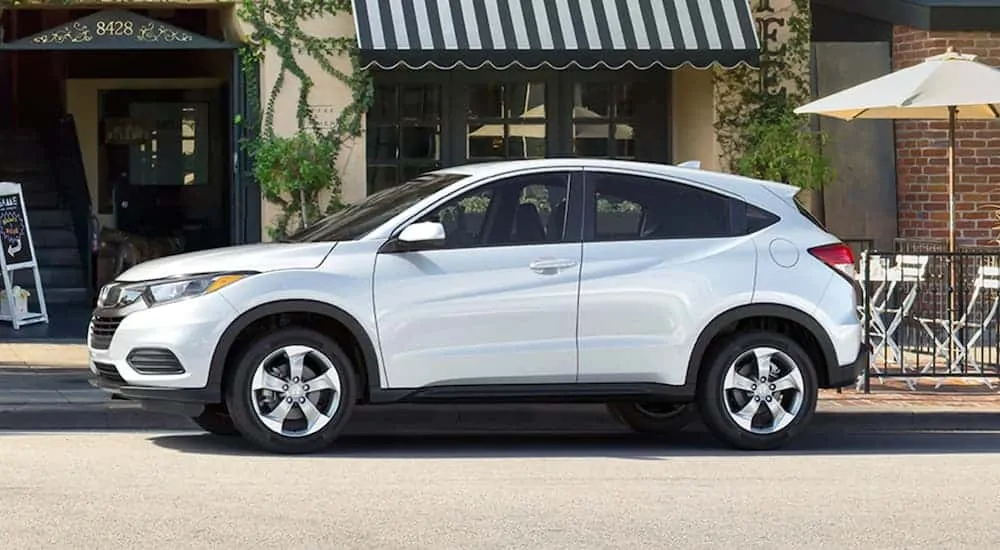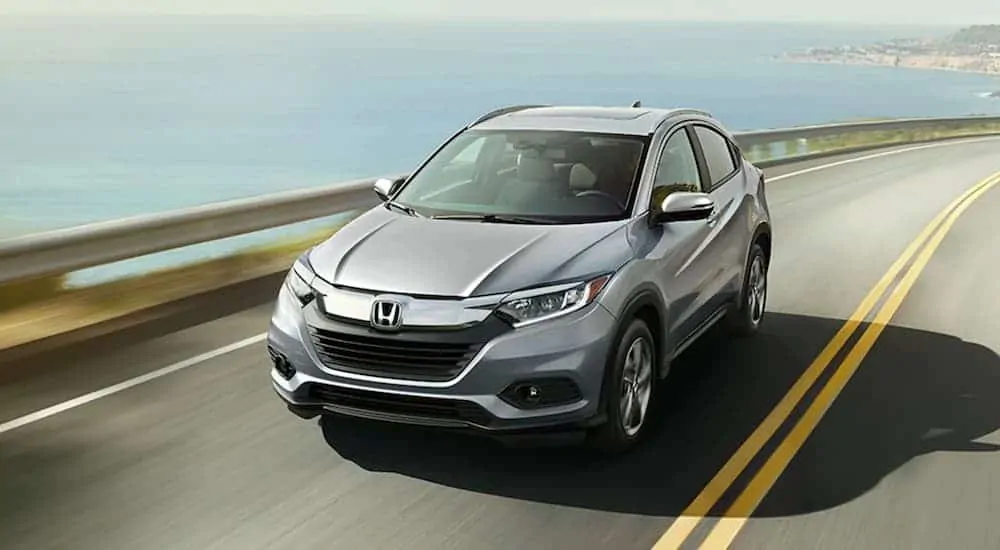If you’ve been looking into options for Crossovers or SUVs, you wouldn’t be the only one. Millions of SUVs are sold every year in what has rapidly become the hottest market in the automotive industry. When a market’s hot, there will be a lot of competition. And a lot of competition is really great for the consumer because there will be a lot of options (unless you don’t like options, of course). Fortunately, we’re here to bring you some details on a member of Honda’s SUV lineup, the 2020 Honda HR-V.
A Brief History
The Honda HR-V isn’t a name that exactly rolls off the tongue, and it can be a bit confusing when Honda already has the CR-V. Compared to the CR-V, the HR-V is much less known, at least here in North America. It’s actually been around since the late 1990s, but the first generation was phased out in 2006. And, it should be mentioned, the primary marketing for the HR-V was in other parts of the world. Come 2015, the second generation of the HR-V is selling in the United States, and now today, we’re up to the 2020 model.
Trims & Pricing
Obviously, one of the most important aspects of looking into a new car is seeing if it falls within your projected price range. Because the HR-V is Honda’s smallest vehicle in their SUV lineup, you can expect pricing that reflects its position.
Starting at $20,820 on the LX trim, we’re actually at a very low price point. Most people would consider being around the $20,000 mark to be quite affordable in this day and age, but they wouldn’t typically think of an SUV for that price. Well, it’s not exactly a new concept, but welcome to the subcompact SUV market, where you can find machines that are similar to sedans (in price and sometimes looks), yet they tend to have a lot more versatility.
Moving on from the LX, the other trims are the Sport ($22,520), EX ($23,970), EX-L ($25,570), and Touring ($28,890). As you can see, the starting prices don’t go over $30,000, which is commonplace for this category.

Performance & Drivetrain
It would probably be too much to ask for a lot when it comes to the performance of a subcompact SUV, but that’s also not usually what a consumer in this market is looking for. On every 2020 Honda HR-V trim level, you’ll get an in-line 4-cylinder engine with 141 hp and 127 lb-ft of torque. That’s not necessarily a lot of power, but that’s to be expected. Besides, you’re looking at fuel economy numbers of 28 city/34 highway/30 combined MPG (on 2WD trims). That’s quite respectable and for many, well worth the trade-off.
Honda’s Real Time All-Wheel Drive is available across all trim levels, although it comes standard on the Touring model. With AWD, the fuel economy will drop to 27 city/31 highway/29 combined MPG. It is nice that even on the lowest option (LX), you can still add on the available AWD. So, if you’re looking for the no-frills base model, but still want some versatility (at a low price)—you’ve got it.
Features
Honda vehicles are known for their technology, so it’s no surprise to find many features available on the HR-V. However, we will hit on some of the key features and highlight a few that you may find more important.
First off, let’s look into the Honda Sensing Safety and Driver-Assistive Technologies. It’s quite a mouthful, but that seems to be the case when it comes to the different safety suites of features from car manufacturers. The main features of Honda’s suite can be separated into two groups, which, as you may have guessed, are the Honda Sensing Technologies and the Driver Assistive Technologies.
The Honda Sensing Technologies include six different features, which you can read all about on Honda’s website. Increasingly common ones include Lane Departure Warning and Lane Keeping Assist System, but you also have Adaptive Cruise Control and Forward Collision Warning. The Driver Assistive Technologies include Honda LaneWatch and Auto High-Beam Headlights. All of these features come standard starting with the EX model and up.
Other features starting at the EX model are heated front seats, a moonroof, a 180-watt audio system with six speakers, and SiriusXM Radio. This is also where you’ll find Push Button Start and heated power side mirrors. The Touring model is the only variant that comes with the Satellite-Linked Navigation System, HomeLink Remote System, Driver’s Seat with 8-Way Power Adjustment, and LED Headlights with Auto-On/Off. Both the EX-L and Touring models come with leather-trimmed seats.
Each trim level comes with all-season tires and a compact spare tire, but roof rails only start at the Sport level. Seating capacity is up to five passengers, which is typical. Atypical, perhaps, is the HR-V Magic Seat. The 60/40 split 2nd-row seating can be completely folded down, or you can fold down one side or the other, depending on your cargo space needs. If you’re trying to load an exceptionally long item, you can also fold down your passenger-side front seat (along with the rear seat) for the accommodation of items up to 8 feet long. It’s also very convenient that you can fold the 2nd-row seats up. This means you can fold the actual seating area up, which allows space for any taller items you may have, like a bicycle. Of course, the possibilities here are endless, and it’s a real huge nod to the HR-V’s versatility.
Starting at the Sport level, you’ll find both Apple CarPlay and Android Auto Integration. HondaLink will also be available starting here, as will Pandora Radio compatibility. There are two USB ports available (the LX only has one) and two 12-volt power outlets (all levels).
Choosing the Best Configuration
While there may be an argument for all of the different configurations of an HR-V, we feel that starting out on the EX trim would be a great move. One of the best parts about starting here is you’ll have all of the Honda safety features come standard. Unfortunately, the LX and Sport do not have those safety features. We would also suggest opting for AWD if it’s important to you. Adding AWD can be like adding another safety feature in and of itself. Having that extra bit of traction and control can be quite important in many different types of driving conditions. Also, if you just want more versatility, then AWD will give you that. Anyone up for a little adventure?
Apart from the safety features and AWD, the starting price of an EX model is actually not too much more than that of an LX. When comparing the LX and Touring models, it’s a lot bigger of a gap (about $8,000), but honestly still not incredibly high. However, the EX still seems like a great middle-ground to shoot for that will make sure you’re not breaking the bank and still getting a lot of very nice features. The EX-L doesn’t seem to add enough to warrant paying a bit more unless you really want leather-trimmed seats, but you don’t want to jump all the way to the Touring. Overall, the 2020 Honda HR-V seems to have a lot of bang for the buck.





